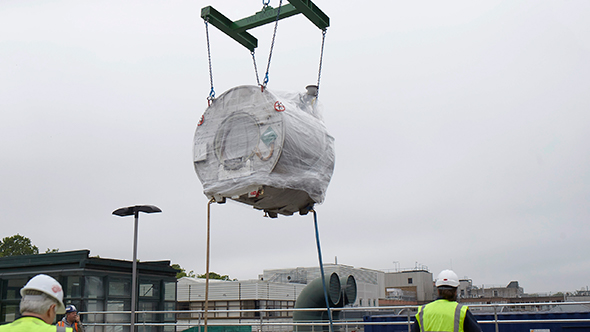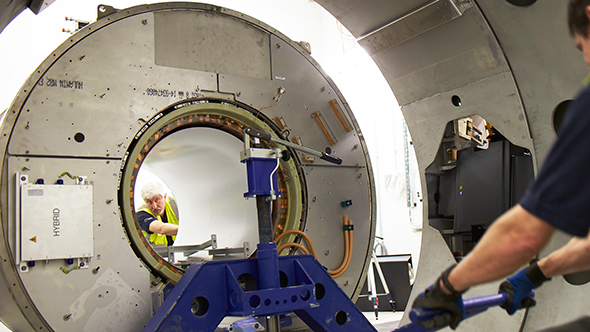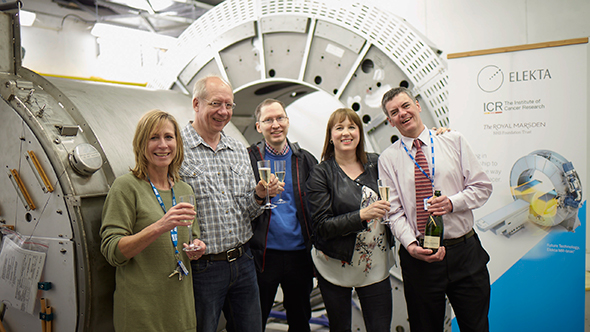A new type of radiotherapy machine, the first of its kind in the UK, is being delivered and assembled at the Sutton site of The Institute of Cancer Research, London, and The Royal Marsden NHS Foundation Trust.
The MR-Linac combines two technologies, an MRI scanner and an ultramodern radiotherapy system, to precisely locate tumours, tailor the shape of X-ray beams in real time and accurately deliver doses of radiation even to moving tumours.
In May, the gantry — providing the scaffold for the linac that delivers the radiotherapy — was delivered to the site and put in place. This week, the high-quality magnet for the MRI machine arrived. These two larger pieces of the machine were lowered into the new facility through a skylight using a crane. Representatives from Elekta, the company who has supplied the machine, will be working on site alongside ICR and Royal Marsden staff to assemble the machine.
Real-time imaging of tumours
Professor Uwe Oelfke, Head of the Joint Department of Physics at the ICR and The Royal Marsden, describes the potential of the new technology. “We have seen radiotherapy improve dramatically in recent years and it plays a significant role in many cancer patients’ treatment,” he says. “To fully unlock the potential of radiotherapy, however, we need to be able to image the tumour in real-time while delivering treatment.
“The MR-Linac holds this promise and we hope it will allow us to target treatment to the cancer of individual patients, opening up a new era of personalised radiotherapy.”

The magnet for the MR-Linac is lowered into position (image courtesy of Elekta)
Alongside the machine delivery and installation, essential research is being done to prepare for the new technology. Dr Simeon Nill is a clinical scientist who works closely alongside Professor Oelfke. “Delivering radiotherapy while using MRI is a huge technical challenge, not least because the MRI magnetic field interacts with the secondary electrons produced by the radiotherapy beam,” he says.
“We have been investigating this effect for the treatment of lung cancer and could show that the impact on delivered doses is minimal.”
Adapting treatment
Another challenge is the ability to respond quickly to the information given by the MRI images.
Currently, radiotherapy is planned well in advance, usually from X-ray images taken from high-tech scans ahead of the treatment being given to the patient. Doctors have time to plan their approach and consider how best to deliver radiotherapy to the tumour with minimal harm to healthy tissue.
However, this procedure cannot account for anatomical changes of the patient occurring between the time of treatment planning and treatment delivery. Using the new MR-guided radiotherapy clinicians will allow to adapt the treatment in real-time using information from high-quality MR images acquired at the time of treatment. Scientists are doing research to understand the best way to process this information to make good clinical decisions in future.

The heavy magnet for the MR-Linac is carefully manoeuvred (image courtesy of Elekta)
The ICR and Royal Marsden are part of an international MR-Linac research consortium. Different partners are leading on different areas of research and it is expected that this sharing of knowledge will accelerate the translation of this technology to the clinic.
'Improved precision'
Professor Kevin Harrington, Joint Head of the Division of Radiotherapy and Imaging at the ICR, explains the importance of the project for patients. “Radiation plays a central role in approximately 50% of patients who are ultimately cured of cancer, but still causes anxiety among patients who fear negative post-treatment side-effects,” he says.
“MR-Linac has the potential to radically improve the precision of radiation delivery, eliminating the need for wide margins around a targeted tumor and significantly decreasing exposure to healthy tissues that might have been adversely impacted by older radiation technology. We expect MR-Linac to increase doctors’ confidence in treating the intended target, while also putting patients at ease.”
The project has multiple partners and funders. The MR-Linac is funded by a £10 million grant from the Medical Research Council with additional funding from the Royal Marsden Cancer Charity. The application for the grant was a joint effort between the ICR, The Royal Marsden, the UK research partnership and Elekta, developer of the pioneering radiotherapy system. Cancer Research UK are a major funder of the preparatory research going on at the ICR that will pave the way for the new technology.
Keep an eye on our Science Talk blog for further updates on the MR-Linac and our radiotherapy research.

Some of those involved in the MR-Linac project celebrate the installation of the giant magnet (image courtesy of Elekta)
- Visit our MR Linac page for more information relating to this project